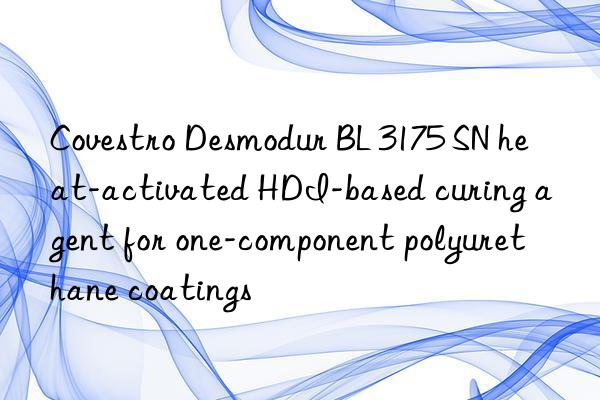
|
Type |
Based on Blocked polyisocyanate of hexamethylene diisocyanate |
|
Supply form |
75%100# Solvent Naphtha Solution |
|
Purpose |
with Desmophen®-type products are used to prepare light-resistant one-component polyurethane baking coatings; in traditional Used as an additive in baking systems to improve the flexibility and adhesion of paint films |
Product Specifications
|
Features |
Value |
Measurement units |
Method |
|
Non-volatile component content(0.2g/60min/80°C) |
75±2 |
% |
DIN EN ISO 3251 |
|
Viscosity,23°C |
2800 |
mPa·s |
DIN EN ISO 3219/A.3 |
|
Equivalent |
Approx. 378 |
|
|
|
Density,20°C |
Approx. 1.06 |
g/ml |
DIN EN ISO 2811 |
|
Flashpoint |
approx. 45 |
°C |
DIN 53 213/1 |
*The above values are general information and are not part of product specifications.
Solubility/Dilution
Desmodur® BL 3175 SN generally has good miscibility with the following solvents, but the storage stability of the resulting solution must be tested. Desmodur® BL 3175 SN can be diluted with ketones, esters, ether esters and aromatic solvents to a solution of 40% solids (by weight). Use a high boiling point aromatic hydrocarbon solvent, such as a mixture of 100# and 150# solvent naphtha to dilute it to a solution with a solid content of 60% (by weight).
Do not use aliphatic hydrocarbon solvents.
Compatibility Desmodur® BL 3175 SN can generally be used with Desmophen® 651, 670, 680, 690, RD 181, A 160, A 265, A 365, A 450 and A 565 in equivalent equivalent proportions (NCO/OH=1.0). and Desmophen T 1665 miscible. It can also be used with various plasticizers, such as phosphoric acid, sulfonic acid, adipic acid and phthalate esters. However, the resulting mixture must be tested for miscibility.
Features/Applications
Desmodur® BL 3175 SN can be used as a curing agent in color-preserving and weather-resistant one-component polyurethane coatings. Adding a catalyst, such as dibutyltin dilaurate (DBTL), can significantly reduce the baking temperature without affecting storage stability. This product can be used in the primer, second coat and topcoat of high-quality industrial decorative paints (electrical appliances, small components, can coatings, coil coatings, etc.) as well as automotive decorative paints. Desmodur® BL 3175 can also be used as an additive in traditional baking systems to improve the flexibility and adhesion of the paint film. When Desmodur® BL 3175 is mixed with Desmophen® 651, the possible baking cycles are:
No catalyst 160℃ 60 minutes
180℃ 15 minutes
200 ℃ 7 minutes
Using catalyst 130℃ 60 minutes
150℃ 15 minutes
175℃ 7 minutes
Depending on the co-reactant used and the baking time, the paint film may turn yellow when the temperature is above 160°C. When Desmodur® BL 3175 is used in coil coating systems, it can be fully cross-linked at the maximum plate temperature of about 241°C and above without adding catalyst DBTL. If 1% DBTL (calculated based on resin solid content) is added, the same effect can be obtained when the maximum plate temperature is approximately 224°C.
Safety: Hazard Identification
It is flammable, may be irritating to skin and mucous membranes, and can easily cause allergies, so special care must be taken when using it. Harmful to aquatic life and may have long-term adverse effects on the aquatic environment.
Its vapor may cause drowsiness and dizziness.
The Safety Data Sheet (028952) must be strictly adhered to. It includes information on labeling, transportation and storage, as well as information on product use, product safety and ecology.
No catalyst 160℃ 60 minutes
180℃ 15 minutes
200 ℃ 7 minutes
Using catalyst 130℃ 60 minutes
150℃ 15 minutes
175℃ 7 minutes
Depending on the co-reactant used and the baking time, the paint film may turn yellow when the temperature is above 160°C. When Desmodur® BL 3175 is used in coil coating systems, it can be fully cross-linked at the maximum plate temperature of about 241°C and above without adding catalyst DBTL. If 1% DBTL (calculated based on resin solid content) is added, the same effect can be obtained when the maximum plate temperature is approximately 224°C.
Safety: Hazard Identification
It is flammable, may be irritating to skin and mucous membranes, and can easily cause allergies, so special care must be taken when using it. Harmful to aquatic life and may have long-term adverse effects on the aquatic environment.
Its vapor may cause drowsiness and dizziness.
The Safety Data Sheet (028952) must be strictly adhered to. It includes information on labeling, transportation and storage, as well as information on product use, product safety and ecology.

 微信扫一扫打赏
微信扫一扫打赏

